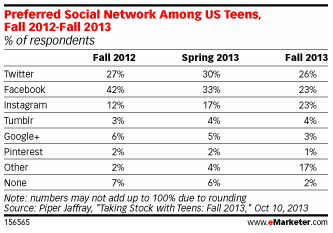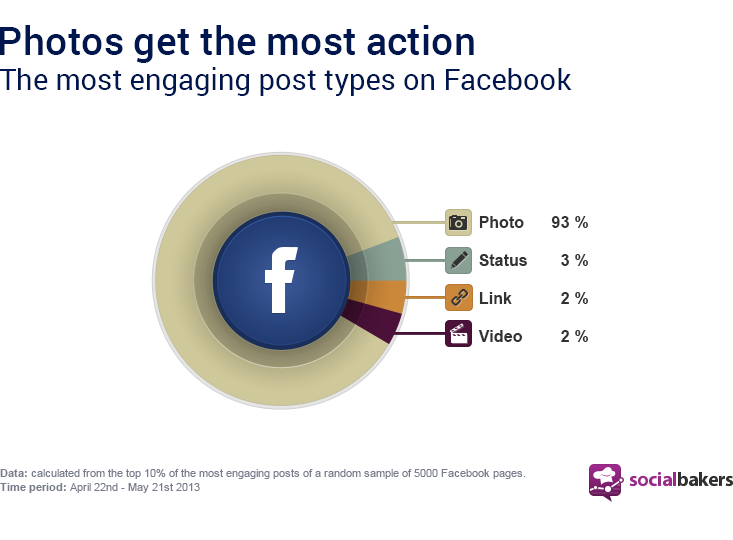As a new year begins, many higher education institutions may be considering how to best allocate their social media marketing resources. With over 1.2 billion total users, Facebook remains far and away the world’s dominant social network, but despite excellent recent earnings results it made a worrying admission that it is seeing a “decrease in daily users, specifically among teens”. This is of particular concern for college and university admissions teams looking to reach high school students by developing intricate Facebook campaigns. In the coming year, Global Web Index founder Tom Smith predicts, “we’ll continue to see active [teen Facebook] use decline and see the rise of very targeted apps, as mobile becomes the primary form of Internet [use] among younger groups.”
While Facebook usage continues to grow rapidly in several emerging markets, it seems to have reached a saturation point in North America and may even be becoming a victim of its own popularity. A vast majority of teenagers continue to use it but their enthusiasm is steadily shifting to mobile chat services and photo-sharing apps like Instagram (owned by Facebook) and Snapchat (which rejected Facebook’s $3 billion acquisition offer). They are becoming less likely to post status updates or photos now that they know that their parents (and other older relatives, college administrators, border police, the NSA, etc.) are watching. Parent-teacher warnings about the repercussions of negative Facebook comments are persuading some young teens to deactivate their accounts.
A May 2013 report by Pew found many teens associated the social network with “constraints through an increasing adult presence, high-pressure or otherwise negative social interactions (‘drama’), or feeling overwhelmed by others who share too much.” The tendency towards “oversharing” might be shrinking on Facebook but it is increasingly migrating to trendier under-the-radar platforms where posts are more ephemeral. Snapchat’s text, photo or video “snaps” disappear after 1 to 10 seconds, depending on how they are set up, and as of November, daily photo “snaps” had skyrocketed to 400 million (compared to Facebook’s 350 million).
The gentrification of Facebook
Urban dwellers will be familiar with the phenomenon of gentrification, through which deteriorating neighbourhoods are upgraded and adopted by wealthier people, resulting in the gradual displacement of the artists and poorer residents that arguably gave an area its original appeal. Founder Mark Zuckerberg may protest that Facebook was never cool in the first place but that doesn’t mean that he isn’t making every effort to appeal to teens, who as intrepid trendsetters are an important barometer for brands, particularly in the realm of social media. In November, the site gave teens the unprecedented option of making their profiles public while also allowing them to activate the “Follow” feature, which mimics the public nature of Twitter by permitting others to view their posts regardless of whether they have accepted a friend request.
Image scanning an increasing trend
As the social media environment becomes ever more cluttered, when teens and others do use Facebook these days it is increasingly to scan the images of newsfeeds rather than posting personal details. A major trend of 2013 was the rise of image-sharing applications, and a study from Socialbakers found that photos make up 93 percent of the most engaging posts on Facebook. Colleges and universities should take advantage of the recent change allowing users to embed photos into their comments on posts, adding a relevant description to clarify the context. Teens respond well to random humour in pictures, which encourages the possibility of viral sharing, but ensure that posted content doesn’t swing so far in this direction that it risks compromising the professional integrity of your institution. Organize your photos into albums so that prospects are able to scan a subject, such as Homecoming or Convocation, in a glance.
Not quite “dead and buried”
While a widely repeated quotation from anthropologist Daniel Miller recently alleged that Facebook is “basically dead and buried” among 16- to 18-year-olds in the UK (according to research in only three schools north of London), the reality is not so simple. Reports suggest that many teens manipulate their likes, posts and comments to make themselves look more popular. Even those not currently interacting with the platform on a daily basis tend to maintain their accounts and could quite conceivably become the adults who still frequent it in a few years time. Its intergenerational popularity across a diverse range of users and purposes should continue to make it an online account almost as common as personal email for the foreseeable future, or at least protect it from the fate of becoming a social network wasteland like MySpace.
Conclusions
The jury is still out on how effective Facebook is for higher education marketing. Social media interaction often occurs early in the conversion cycle, which makes return on investment difficult to gauge. A recent study from Stone Temple Consulting suggests Facebook lacks the SEO benefits for schools possessed by Google+, as search engines can’t determine whether endorsements are coming from highly reputable sources or low-ranking pages that sell Likes. Even when teenaged prospects like your page, there is no guarantee that your content will show up on their newsfeeds. That is based on their complex algorithm that considers over a thousand variables to determine “high quality content.”
The increasing monetization of the platform presents increased opportunities for marketers but the return on investment for colleges and universities is highly speculative at this point. Advertisements continue to creep into newsfeeds as the site experiments with how much its users are willing to tolerate. The visibility and specific targeting of feed-based ads have provided promising results thus far but the ever more costly nature of this pay-to-play trend may prove too great a strain for many higher ed marketing budgets to take.
Changing trends in teenager preferences are obviously a concern for admissions departments but even if Facebook becomes less of a student recruitment tool, it remains a necessity for engaging with your communities of admitted and current students. Don’t rely on it exclusively to direct students to your content but by all means continue to use it and other social media to promote blogs from your website, encourage engagement with photos and video links, and as a valuable platform to connect while letting students connect with each other.
What Does Facebook’s Shrinking Teen Usage Mean For Your School?








